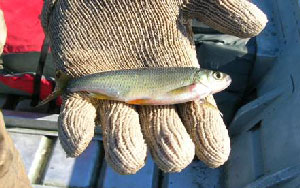Golden Shiner
Notemigonus crysoleucas
 Distribution: The original range of the golden shiner includes the Great Lakes, Mississippi River, Atlantic coast, and Gulf coast drainages from Nova Scotia to Texas. Golden shiners have been widely introduced throughout North America. They are common and widespread throughout New Hampshire.
Distribution: The original range of the golden shiner includes the Great Lakes, Mississippi River, Atlantic coast, and Gulf coast drainages from Nova Scotia to Texas. Golden shiners have been widely introduced throughout North America. They are common and widespread throughout New Hampshire.
Description: The golden shiner is a slab shaped minnow with golden colored scales and a lateral line that curves downward into the lower third of its body. Juvenile golden shiners have a dark lateral band and are easily confused with other minnow species when observed in the water.
Species commonly confused with: Fallfish, common shiner, creek chubsucker, bridle shiner
Habitat: Golden shiners are usually associated with aquatic vegetation in lakes, ponds, or slow moving sections of rivers and streams.
Life History: Golden shiners are a common minnow species found throughout New Hampshire. Golden shiners lay adhesive eggs  that stick to stands of aquatic vegetation. Extremely prolific, the female golden shiner can lay 200,000 eggs multiple times during the growing season. Its prolific nature makes the golden shiner a valuable source of prey in lakes and ponds throughout the state. Golden shiners are capable of both filter feeding and catching small invertebrates or fish. Plant material makes up a large portion of their diet. Golden shiners are fast growers and may reach sizes of up to 12 inches. They are widely used as bait by anglers.
that stick to stands of aquatic vegetation. Extremely prolific, the female golden shiner can lay 200,000 eggs multiple times during the growing season. Its prolific nature makes the golden shiner a valuable source of prey in lakes and ponds throughout the state. Golden shiners are capable of both filter feeding and catching small invertebrates or fish. Plant material makes up a large portion of their diet. Golden shiners are fast growers and may reach sizes of up to 12 inches. They are widely used as bait by anglers.
Origin: Native
Conservation/Management: There are no specific conservation or management objectives for golden shiners. Widespread introductions of golden shiners may have reduced the diversity of minnow species in lake and pond habitat throughout the northeast.



